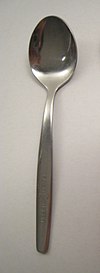Teaspoon: Difference between revisions
→Measure of volume: Streamline and organize text |
→Measure of volume: typo |
||
| Line 14: | Line 14: | ||
In some countries, a '''teaspoonful''' — as much as one teaspoon can hold — is used as a [[Cooking weights and measures|unit of volume]], especially in [[cooking]] [[recipe]]s and [[pharmacology|pharmaceutic]] [[medical prescription|prescriptions]]. It is abbreviated in English as ''t.'', ''ts.'', ''tsp.'' or ''tspn.'' (German and Dutch: ''TL'', from ''Teelöffel'' or ''Theelepel''). |
In some countries, a '''teaspoonful''' — as much as one teaspoon can hold — is used as a [[Cooking weights and measures|unit of volume]], especially in [[cooking]] [[recipe]]s and [[pharmacology|pharmaceutic]] [[medical prescription|prescriptions]]. It is abbreviated in English as ''t.'', ''ts.'', ''tsp.'' or ''tspn.'' (German and Dutch: ''TL'', from ''Teelöffel'' or ''Theelepel''). |
||
For classic purposes in the United States, one teaspoon is precisely {{frac|768}} of a U.S. liquid gallon (see [[United States customary units]]). This is precisely {{val|4.92892159375}} mL and {{frac|231| |
For classic purposes in the United States, one teaspoon is precisely {{frac|768}} of a U.S. liquid gallon (see [[United States customary units]]). This is precisely {{val|4.92892159375}} mL and {{frac|231|768}} ({{val|0.30078125}}) [[cubic inch]]. It is also equal to {{frac|3}} [[tablespoon]], |
||
{{frac|6}} U.S. [[fluid ounce|fl. oz]], and {{frac|48}} of [[Cup (volume)|U.S. customary cup]]. For nutritional labeling purposes on food packages in the U.S., the teaspoon is, by Federal regulations, rounded to precisely 5 [[millilitre|mL]], per [http://edocket.access.gpo.gov/cfr_2004/aprqtr/21cfr101.9.htm 21CFR101.9](b)(5)(viii). |
{{frac|6}} U.S. [[fluid ounce|fl. oz]], and {{frac|48}} of [[Cup (volume)|U.S. customary cup]]. For nutritional labeling purposes on food packages in the U.S., the teaspoon is, by Federal regulations, rounded to precisely 5 [[millilitre|mL]], per [http://edocket.access.gpo.gov/cfr_2004/aprqtr/21cfr101.9.htm 21CFR101.9](b)(5)(viii). |
||
Revision as of 22:49, 25 May 2009


A teaspoon, a type of cutlery (American English also: flatware), is a small spoon, commonly silver and part of a place setting, suitable for stirring and sipping the contents of a cup of tea or coffee. Utilitarian versions are used for measuring.
Teaspoons with longer handles, such as iced tea spoons, are commonly used also for ice cream. Similar spoons include the tablespoon and the dessert spoon, the latter intermediate in size between a teaspoon and a tablespoon, used in eating dessert and sometimes soup or cereals. Much less common is the coffee spoon, which is a smaller version of the teaspoon. Another teaspoon, called an orange spoon, tapers to a sharp point or teeth, and is used for citrus fruits and melons. A bar spoon, equivalent to a teaspoon, is used in measuring ingredients for mixed drinks. The tablespoon is a larger version of the teaspoon, generally with three times its capacity.
A container designed to hold extra teaspoons, called a spooner, formed part of a 19th century table service.
Measure of volume
In some countries, a teaspoonful — as much as one teaspoon can hold — is used as a unit of volume, especially in cooking recipes and pharmaceutic prescriptions. It is abbreviated in English as t., ts., tsp. or tspn. (German and Dutch: TL, from Teelöffel or Theelepel).
For classic purposes in the United States, one teaspoon is precisely 1⁄768 of a U.S. liquid gallon (see United States customary units). This is precisely 4.92892159375 mL and 231⁄768 (0.30078125) cubic inch. It is also equal to 1⁄3 tablespoon, 1⁄6 U.S. fl. oz, and 1⁄48 of U.S. customary cup. For nutritional labeling purposes on food packages in the U.S., the teaspoon is, by Federal regulations, rounded to precisely 5 mL, per 21CFR101.9(b)(5)(viii).
Common teaspoons such as bar spoons for measuring ingredients and stirring mixed drinks are often not designed to contain a standard volume. In practice, they may hold anything between 2.5 mL and 6 mL of liquid, so caution must be employed when using a teaspoon to measure a prescribed dose of medicine. For this reason and in order to avoid dispensing errors, special measuring spoons are available that hold exactly 5 mL. The common teaspoon is always smaller than the tablespoon.
If a recipe calls for a teaspoonful of a powder ingredient (salt, flour, etc.), this normally refers to an approximately levelled filling of the spoon, just as with liquids. For example, a teaspoon of salt for cooking purposes, is 5 mL or about 4.75 grams.
Some recipes also call for heaping (American English) or heaped (British English) spoon measures. Such a heaping/heaped teaspoon, refers to an inexact volume of the required ingredient, obtained by scooping it up with a teaspoon and not levelling it off. The amount obtained by heaping a spoon can easily vary by more than a factor of two. An even less precise term, dash, signifies a very small quantity of liquid or dry ingredients, ranging up to 1/4 teaspoonful, added to food or drink.
